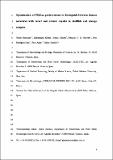Por favor, use este identificador para citar o enlazar a este item:
http://hdl.handle.net/10261/158997COMPARTIR / EXPORTAR:
 SHARE SHARE
 CORE
BASE CORE
BASE
|
|
| Visualizar otros formatos: MARC | Dublin Core | RDF | ORE | MODS | METS | DIDL | DATACITE | |

| Título: | Optimization of PMAxx pretreatment to distinguish between human norovirus with intact and altered capsids in shellfish and sewage samples |
Autor: | Randazzo, Walter CSIC ORCID; Khezri, Mohammad; Ollivier, Joanna; Le Guyader, Françoise S.; Rodríguez Díaz, Jesús CSIC ORCID; Aznar, Rosa CSIC ORCID; Sánchez Moragas, Gloria CSIC ORCID | Palabras clave: | Viability PCR Norovirus Shellfish Intercalating dyes Sewage RT-qPCR |
Fecha de publicación: | 15-nov-2017 | Editor: | Elsevier | Citación: | International Journal of Food Microbiology 266: 1-7 (2018) | Resumen: | Shellfish contamination by human noroviruses (HuNoVs) is a serious health and economic problem. Recently an ISO procedure based on RT-qPCR for the quantitative detection of HuNoVs in shellfish has been issued, but these procedures cannot discriminate between inactivated and potentially infectious viruses. The aim of the present study was to optimize a pretreatment using PMAxx to better discriminate between intact and heat-treated HuNoVs in shellfish and sewage. To this end, the optimal conditions (30 min incubation with 100 μM of PMAxx and 0.5% of Triton, and double photoactivation) were applied to mussels, oysters and cockles artificially inoculated with thermally-inactivated (99 °C for 5 min) HuNoV GI and GII. This pretreatment reduced the signal of thermally-inactivated HuNoV GI in cockles and HuNoV GII in mussels by > 3 log. Additionally, this pretreatment reduced the signal of thermally-inactivated HuNoV GI and GII between 1 and 1.5 log in oysters. Thermal inactivation of HuNoV GI and GII in PBS, sewage and bioaccumulated oysters was also evaluated by the PMAxx-Triton pretreatment. Results showed significant differences between reductions observed in the control and PMAxx-treated samples in PBS following treatment at 72 and 95 °C for 15 min. In sewage, the RT-qPCR signal of HuNoV GI was completely removed by the PMAxx pretreatment after heating at 72 and 95 °C, while the RT-qPCR signal for HuNoV GII was completely eliminated only at 95 °C. Finally, the PMAxx-Triton pretreatment was applied to naturally contaminated sewage and oysters, resulting in most of the HuNoV genomes quantified in sewage and oyster samples (12 out of 17) corresponding to undamaged capsids. Although this procedure may still overestimate infectivity, the PMAxx-Triton pretreatment represents a step forward to better interpret the quantification of intact HuNoVs in complex matrices, such as sewage and shellfish, and it could certainly be included in the procedures based on RT-qPCR. | Versión del editor: | https://doi.org/10.1016/j.ijfoodmicro.2017.11.011 | URI: | http://hdl.handle.net/10261/158997 | DOI: | 10.1016/j.ijfoodmicro.2017.11.011 | ISSN: | 0168-1605 |
| Aparece en las colecciones: | (IATA) Artículos |
Ficheros en este ítem:
| Fichero | Descripción | Tamaño | Formato | |
|---|---|---|---|---|
| IJFM-2018-Randazzo.pdf | Artículo principal | 231,87 kB | Adobe PDF |  Visualizar/Abrir |
CORE Recommender
SCOPUSTM
Citations
78
checked on 25-abr-2024
WEB OF SCIENCETM
Citations
72
checked on 17-feb-2024
Page view(s)
285
checked on 05-may-2024
Download(s)
273
checked on 05-may-2024
Google ScholarTM
Check
Altmetric
Altmetric
Este item está licenciado bajo una Licencia Creative Commons

